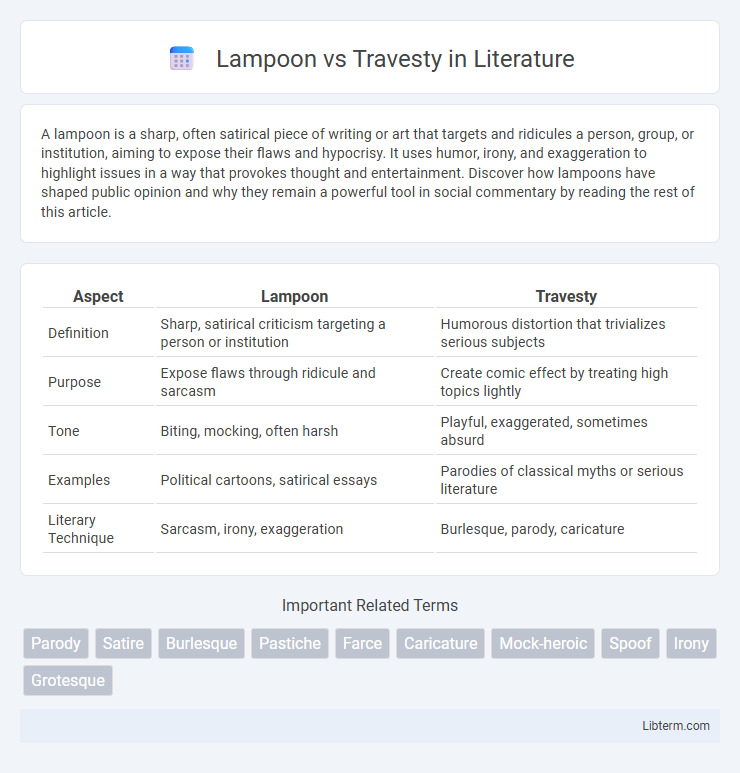A lampoon is a sharp, often satirical piece of writing or art that targets and ridicules a person, group, or institution, aiming to expose their flaws and hypocrisy. It uses humor, irony, and exaggeration to highlight issues in a way that provokes thought and entertainment. Discover how lampoons have shaped public opinion and why they remain a powerful tool in social commentary by reading the rest of this article.
Table of Comparison
| Aspect | Lampoon | Travesty |
|---|---|---|
| Definition | Sharp, satirical criticism targeting a person or institution | Humorous distortion that trivializes serious subjects |
| Purpose | Expose flaws through ridicule and sarcasm | Create comic effect by treating high topics lightly |
| Tone | Biting, mocking, often harsh | Playful, exaggerated, sometimes absurd |
| Examples | Political cartoons, satirical essays | Parodies of classical myths or serious literature |
| Literary Technique | Sarcasm, irony, exaggeration | Burlesque, parody, caricature |
Introduction to Lampoon and Travesty
Lampoon and travesty are both forms of satirical art that mock or ridicule their subjects, but they differ significantly in style and approach. A lampoon employs sharp wit and humor to criticize individuals, institutions, or social issues, often targeting specific traits or actions with exaggerated sarcasm. Travesty, on the other hand, reinterprets serious works by presenting them in a grotesquely distorted or absurd manner, thereby undermining the original tone and intent for comedic or critical effect.
Defining Lampoon: Key Characteristics
Lampoon is a form of satirical writing that uses humor, irony, and exaggeration to criticize or mock individuals, institutions, or societal norms. It often employs sharp wit and vivid imagery to expose flaws, hypocrisy, or absurdities, making the subject appear ridiculous or contemptible. Key characteristics of lampoon include its pointed tone, strategic use of parody, and intent to provoke reflection or reform through biting humor.
Travesty Explained: Essential Features
Travesty is a form of parody that humorously exaggerates and distorts a serious work to highlight its absurdities, often employing incoherent or absurd language and scenarios. Unlike lampoon, which targets individuals or groups with sharp satire, travesty transforms entire genres or narratives into ridiculous imitations, emphasizing outrageousness and comedic incongruity. Essential features include deliberate misrepresentation, exaggerated tones, and a focus on ludicrous reinterpretation of the original material.
Historical Origins of Lampoon
Lampoon traces its historical origins to 17th-century Europe, particularly in France and England, where it emerged as a form of satirical literature aimed at ridiculing public figures and institutions through sharp humor and exaggerated criticism. Unlike travesty, which distorts serious subjects by treating them in a trivial or grotesque manner, lampoons specifically target the flaws and vices of real individuals, often using witty and pointed language. The tradition of lampooning developed alongside the rise of print media, enabling widespread dissemination of these satirical attacks and influencing political and social discourse.
The Evolution of Travesty in Literature
Travesty in literature evolved as a form of parody that distorts and exaggerates serious subjects to highlight their absurdities, differing from lampoon's direct and often personal ridicule. Originating in classical theatrical works, travesty expanded through the Renaissance and Romantic periods to subtly critique societal norms and literary conventions. Modern literature continues this tradition by using travesty to challenge cultural narratives and provoke critical reflection through exaggerated mimicry.
Lampoon vs Travesty: Core Differences
Lampoon and travesty both involve satire but differ fundamentally in style and intent, with lampoon focusing on sharp, often humorous critique targeting individuals or institutions through exaggerated ridicule. Travesty transforms serious subjects into absurd or grotesque imitations, stripping original significance to provoke amusement or shock. The core difference lies in lampoon's direct, pointed mockery versus travesty's broad, absurd distortion of form and content.
Purposes and Intentions Behind Lampoon
Lampoons aim to ridicule or criticize individuals, institutions, or societal norms through humor and exaggeration, intending to provoke thought or reform by highlighting flaws. Their primary purpose is to entertain while delivering a sharp social or political commentary that encourages reflection and change. The intention behind a lampoon is often more sophisticated, combining wit with satire to engage the audience critically rather than merely mocking.
Notable Examples of Travesty
Notable examples of travesty include Jonathan Swift's "A Modest Proposal," which satirically exaggerates social issues to provoke thought and highlight injustices, and Voltaire's "Candide," a work that mocks philosophical optimism through exaggerated misadventures. These travesties transform serious subjects by presenting them in a distorted, often absurd manner to criticize societal norms and provoke reflection. Unlike lampoon, which targets individuals with sharp wit, travesty generally parodies entire genres or conventions on a broader scale.
Impact of Lampoon and Travesty on Culture
Lampoon and travesty both shape culture by challenging societal norms through satire and parody, fostering critical reflection and dialogue. Lampoon uses sharp wit to mock public figures and institutions, often influencing political discourse and social attitudes. Travesty distorts classic works or genres, highlighting cultural absurdities and prompting audiences to reconsider established values and traditions.
Choosing Between Lampoon and Travesty in Creative Writing
Choosing between lampoon and travesty in creative writing depends on the tone and intent; lampoon employs sharp satire to ridicule individuals or institutions, often using humor to expose flaws, while travesty distorts serious subjects by presenting them in a grotesque or absurd manner, undermining their original significance. Writers seeking to critique social or political targets with wit and precision often prefer lampoon for its incisive edge, whereas those aiming to highlight the ridiculous nature of solemn topics through exaggeration lean toward travesty. Understanding the nuanced differences in their rhetorical impact enables authors to effectively engage audiences and convey their intended message.
Lampoon Infographic

 libterm.com
libterm.com